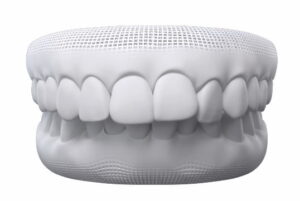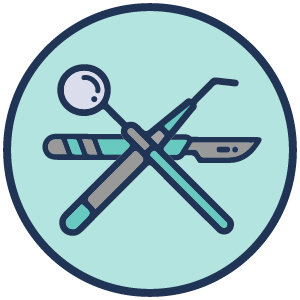Even if you’re unfamiliar with the clinical terminology, chances are you’ve seen—or even experienced—an overbite. Often referred to as an “overjet” or “deep bite,” this is one of the most common types of malocclusion that orthodontists treat.
Malocclusion is a general term used when the upper and lower jaws don’t align properly. It comes from the Latin words “mal” (bad) and “occlusion” (bite). An overbite specifically refers to a condition where the upper teeth extend noticeably beyond the lower teeth when the mouth is closed.
A slight overbite is actually a normal part of healthy jaw structure. In fact, most people have some degree of overbite. When functioning properly, your upper teeth rest slightly over your lower teeth to allow for smooth biting and chewing. However, if the overlap becomes too pronounced, it can interfere with oral function, impact your appearance, or contribute to dental health issues. That’s when it becomes a case of malocclusion—and when orthodontic care becomes important.
At Beverly Hills Orthodontics, correcting overbites is a routine part of what we do. Since opening our doors in 2008, we’ve treated thousands of cases involving bite alignment and jaw positioning, and overbite treatment remains one of the most common reasons patients come to see us.
Naturally, it’s also one of the topics we discuss most during consultations. Some of the most frequent questions we hear include:
- Do braces fix overbites?
- How long does treatment take?
-
Are there health benefits to treating an overbite?
Our BHO team will answer these and more in the sections below, as we break down what causes overbites, how they’re treated, and what you can expect from the process.
Do Braces Fix Overbites? Yes.
But Wait—There’s More!
The simple answer to “Do braces fix overbites?” is “yes.” The longer answer is “yes, but the braces are just one part of the treatment.”

Malocclusions are grouped into different classes and divisions based on the nature and severity of the misalignment.
Class 1 malocclusions (aka neutrocclusion) display a normal, healthy alignment between the upper and lower jaws but may exhibit some minor problems, like dental crowding or spacing issues.
Overbites fall under Class II malocclusions, which are organized into two divisions:
- Division 1, in which the upper front teeth either protrude forward or are positioned improperly. With Division 1 malocclusions, the lower lip is frequently positioned behind the upper teeth. This accentuates the difference between the upper and lower jaws, significantly affecting the patient’s facial appearance.
- Division 2, in which the upper front teeth recline toward the lower teeth, obscuring the fact that the upper jaw protrudes over the lower jaw. In the most extreme cases, the upper teeth fully hide the lower teeth when the patient bites down. These severe cases are called “deep overbites” or “supraocclusions”
Orthodontists use a variety of methods to treat malocclusions of different classes and severity levels. Used in combination with braces, these measures shift the lower jaw into the desired position while braces straighten teeth by applying pressure to them.
During your initial consultation, your orthodontist will examine your bite to better understand exactly what kinds of overbite problems you’re dealing with. They will also discuss which treatment options they recommend for your unique issues.
Overbite Treatment Methods
At Beverly Hills Orthodontics, we use four methods to treat overbites. Before treatment begins, we always discuss available options with patients to determine the approach that best meets their aesthetic goals and lifestyle preferences. Together, we work with patients to create a holistic care plan that is both effective and comfortable. Possible treatment methods include:
- Elastics. Used to correct mild-to-moderate overbites, elastics are rubber bands that overbite patients wear with their braces. The daily pull of the bands gradually draws the lower jaw forward, eventually bringing it into proper alignment with the upper jaw. Elastics are also used for severe underbite cases, or to prepare the jaws for headgear, surgery, or tooth extraction, as well as to maintain progress after treatment.
- Headgear. Designed for treating class II overbites in children aged 7 to 16, headgear stabilizes the upper jaw and teeth to encourage the lower jaw’s differential growth. This method relies on natural somatic development to correct the misalignment. Worn for around 12-14 hours a day for 12-18 months, headgear eliminates overbite issues without the need for surgery or extraction. It also gives patients the aesthetic benefit of creating a strong jawline. Patients older than 16 do not qualify for headgear because their jaws are done growing.

- Jaw Surgery. When headgear isn’t an option and elastics alone are not powerful enough to correct an overbite, jaw surgery is often the next best treatment choice for adult patients. The official term for this procedure, “orthognathic surgery,” involves separating the jawbone to pull the chin forward. By pulling the chin forward, the oral, jaw, and face (maxillofacial) surgeon is able to properly align the upper and lower jaws and create a strong jaw profile.
- Tooth Extraction. In some cases, simple tooth extraction is a viable alternative to surgery. By removing certain teeth, your orthodontist can create the space required to properly align the upper and lower jaws. However, tooth extraction can change the look of your facial profile, including your smile, particularly if you are an older adult.
Patients qualify for these treatments based on a combination of age, misalignment severity, and other health factors. In general, treatment takes around 12-24+ months to complete and provides patients with numerous benefits, including:
- Beautiful, perfectly straight smiles
- Decreased risk of chronic pain
- Clearer speech
- Less dental decay and gum disease
- Improved chewing and eating
- Boosted self-confidence
For more information about overbite treatments, contact one of Beverly Hills Orthodontics’ four Los Angeles-area locations to schedule a consultation.
Interested In Orthodontic Care? A Consultation at Beverly Hills Orthodontics Will Reveal Your Overbite Treatment Options
Braces remain one of the most reliable and effective solutions for correcting overbites. When paired with additional tools—such as elastics, growth-modifying appliances, or, in some complex cases, jaw surgery—orthodontists can successfully treat both mild and severe overbite issues in patients of all ages.
If you have been considering braces for your overbite, Beverly Hills Orthodontics is here to help you review all your treatment options. Our founder, Dr. Monica Madan, graduated from the top orthodontic program in the country and uses the latest orthodontic tools and techniques to create specialized treatment plans. A consultation at one of our offices in Beverly Hills, Studio City, Alhambra, or Downtown LA, will allow our team to pinpoint your exact alignment issues and discuss which care options will work best for your lifestyle. Contact us today to learn more.
